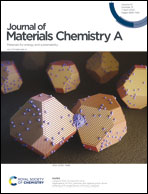Improving charge transport and reducing non-radiative energy loss via a nonacyclic carbazole-based third component for over 18% efficiency polymer solar cells†
Abstract
Sensible selection of host blends and the third component is crucial to give full play to the advantages of the ternary strategy for achieving high efficiency polymer solar cells (PSCs). In this work, a PM6:BTP-BO-4Cl binary system and non-fullerene acceptor DTTC-4ClC9 with the dithienocyclopentacarbazole (DTC) core are selected as the host blend and the third component, respectively. DTTC-4ClC9 and BTP-BO-4Cl are found to have excellent miscibility, and the addition of DTTC-4ClC9 into the binary blend can modify the morphology of the film, which brings out an improved charge transport and obviously enhanced exciton dissociation ability. The non-radiative energy loss of the devices is significantly reduced to 0.207 eV when employing the ternary strategy, thus leading to a reduction in energy loss. As a result, the introduction of 15% DTTC-4ClC9 in the PM6:BTP-BO-4Cl system can promote the power conversion efficiency from 17.11% to remarkable 18.21%, meanwhile, the open-circuit voltage, short-circuit current density, and fill factor are increased simultaneously.



 Please wait while we load your content...
Please wait while we load your content...